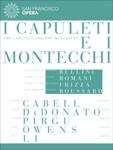|
Back
11/23/2014
Vincenzo Bellini: I Capuleti e i Montecchi
Nicole Cabell (Giulietta), Joyce DiDonato (Romeo), Saimir Pirgu (Tebaldo), Eric Owens (Capellio), Ao Li (Lorenzo), San Francisco Opera Orchestra and Chorus, Ian Robertson (Chorus Director), Laura Albers (Concertmaster), Riccardo Frizza (Conductor), David Gockley (Executive Producer), Vincent Boussard (Stage Director), Vincent Lamaire (Set Designer), Christian Lacroix (Costume Designer), Guido Levi (Lighting Designer)
Live Recording: War Memorial, San Francisco, California (October 2012) – 136’ (+ Bonus material 36’)
EuroArts #2059668 (or Blu-ray #2059664) (Distributed by Naxos of America) – Subtitles in English, German, French and Italian – Booklet in English, German and French

   
Zaira’s impuissant response in 1829 was a blessing in disguise for Vincenzo Bellini. Giovanni Pacini’s simultaneous withdrawal from writing an opera for Venice’s 1929-30 Carnival season left impresario Lanari in the lurch and desperately knocking on Bellini’s door. The re massaged Nicola Vaccai libretto by Felice Romani was all Bellini required in order to create I Capuleti e i Montecchi: he “stole” from Zaira and “gave” to I Capuleti e i Montecchi which proved extremely successful at the La Fenice premiere on March 11, 1830.
Bellini’s Matteo Bandello based tragedia lirica economizes principals to only five when compared to Gounod’s elaborate Shakespearean grounded Roméo et Juliette. There is a greater concentration on the war between the two feuding families and the two protagonists’ struggle for blissful resolve. Never does the pair ever find a true moment of love (until the end) in contrast to Gounod’s work. Vincent Boussard takes a daring abstract approach that’s a bit enigmatic at first glance, but when reflecting, funnels Romeo and Giulietta under a microscope of intense isolation that absorbs the viewer.
Nicole Cabell is a sublime singer and actor. There is a guaranteed richness in tone, and she manages particularly well even when tackling the passages that reach well into her higher tessitura boundaries. Upon first meeting Giulietta, we see her hopping up on a cantilevered porcelain sink (extremely small, yet she manages with great dexterity), trying to climb the wall. It gives the impression of her imprisonment within the Capulet compound in search of her beloved. Lemaire’s vertical faces are obtuse and tall. There’s a great feeling of claustrophobia as Ms. Cabell also claws on the room’s surfaces in complete confinement and torments about love versus duty to family. This scene is handled exceptionally well.
Halfway through this scene Joyce DiDonato secretly (with the help of Lorenzo) arrives in Giulietta’s chamber whose vocal expressions and responses are incredibly riveting. In the bonus supplement Ms. DiDonato talks about how the Lacroix costume breathed more life and connection into her character. This is self-evident throughout the entire opera. Possessive of a warm, buttery register, her projection is undeniably pliable, realistic and concise, especially well rendered during her incredibly difficult aria, “La tremenda ultrice spade” that concludes Scene 1.
Equal in pristine outreach is Giulietta’s intended, Tebaldo, sung by Saimir Pirgu. The notes are solid and confident, restrained with dramatic lining although the closing notes in his first aria, “È serbata a questo acciaro”, are a bit flat. The duel involving Tebaldo and Romeo is rather wobbly and gawky.
Eric Owens holds anchor in the bass reaches as Giulietta’s father, Capellio. His tonal values are firmly stentorian and resolute. Having Owens on stage brings his character to life with a feeling of unwavering authority. After all, it is he whom the Capulets and Montagues blame for the lovers’ final demise. And with this response to Capellio, both factions remove their hats and place them on the ground as a sign of peace…a wonderful Boussard touch. Ao Li, acting as a liaison for trysts between Giulietta and Romeo in the role of Lorenzo, the Physician to the Capulets, reveals a fine baritone delivery.
Boussard creates little in the way of imaginative blocking, but when he does, the movement is slow as molasses. Perhaps that’s his wanted effect. He also likes to have vocalists sing (and at times pose) with their backs to the audience.
Créateur de mode extrordinaire Christian Lacroix dresses San Francisco Opera’s chorus members and principals in an interesting display of contrasting colors and textures. After a lively reading of the “Prelude” by Riccardo Frizza, the first scene opens with Vincent Lemaire’s stirrups and saddles hanging from ropes under which we see a cadre of Dickensian-dressed men who look like they came from A Christmas Carol. Complete with top hats, it is definitive Lacroix: crinkly, ruffled gray jackets and pants, wide scarves and GI boots.
When Nicole Cabell first appears in Scene 2, she is corseted in a white undergarment while half dressed in a wedding dress that’s reminiscent of the Lacroix puffball ”le pouf” skirt with muted textures of light brown and trademark décolleté neckline. The latter note holds true with the women in the Capulet Palace, yet this color pallet is vibrant and rich, along with varying wigs. But the opening “freeze” has women holding a flower with their teeth and they look suggestively demimonde...a bit edgy.
It appears as if Guido Levi’s lighting was slightly guided by Edgar Degas’ paintings. Many moments surface where a face is almost “whited out” to gain effect. Lighting was so intense at times, it nearly obliterated facial expressions which was a bothersome tactic. But other techniques were rendered subtle and tasteful.
The San Francisco Opera company is known for its nicely rounded (yet sometimes daring) selection from the operatic repertoire. It is fortunate to have this 2012 staging of I Capuleti e i Montecchi preserved under the direction of David Gockley. The presentation is spotless and aesthetically pleasing. Although bit beyond mainstream, Vincent Boussard’s production, nonetheless, adds some incisive yet arguable qualities.
Christie Grimstad
|